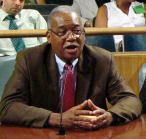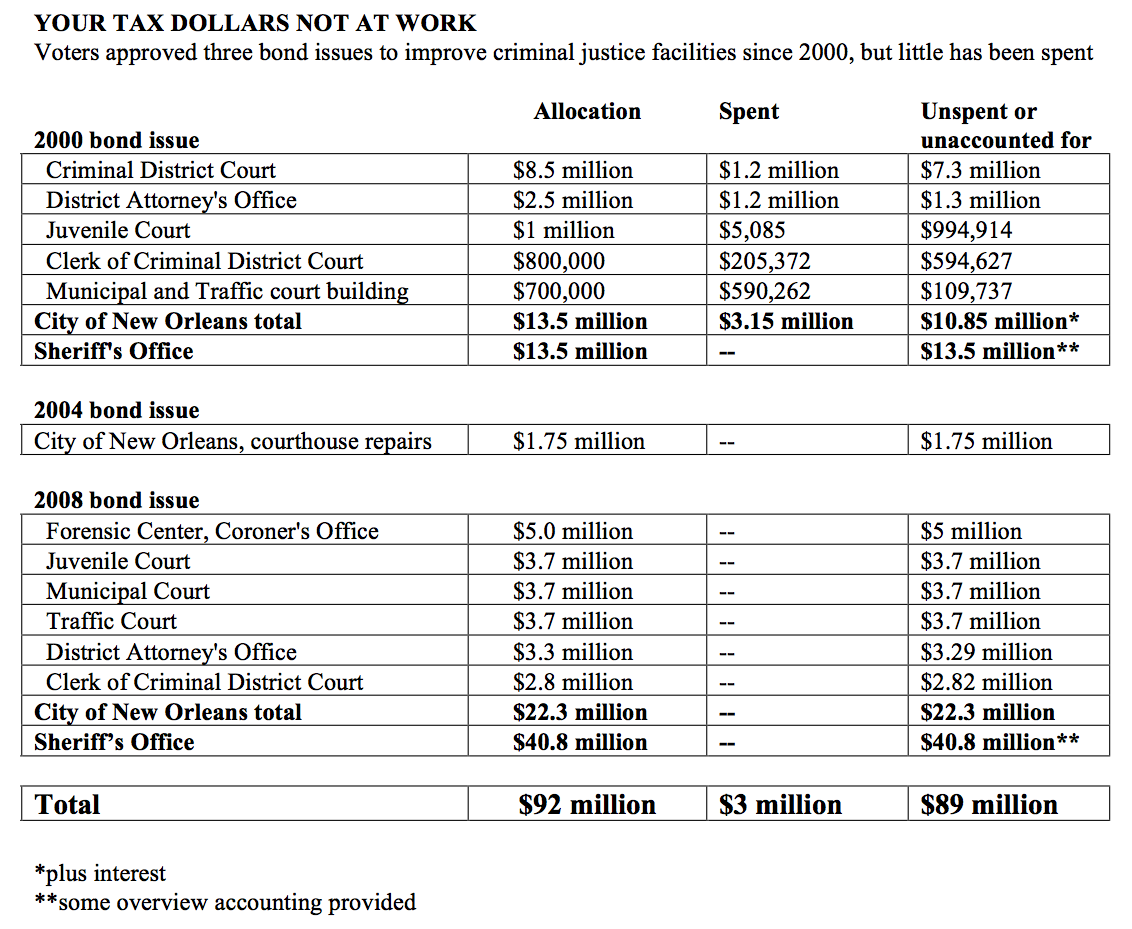See the report from our partners at Fox8 News.
Even as New Orleans city officials struggle to fill a $79 million budget hole, they haven’t fully answered why they continue to sit on a separate $10 million pile of taxpayer money approved by voters a decade ago for courthouse repairs.
City records provided in response to a public-records request show Sheriff Marlin Gusman, who split proceeds from a bond issue with the city administration, urged then-Mayor Ray Nagin to spend the money in 2007. Gusman had long since spent his half of the $27 million that voters approved in 2000.
The city never responded to the sheriff.
An investigation by The Lens and Fox8 News revealed that the city has spent just $3.15 million of its original $13.5 million; no accounting was provided to show how much interest the still-banked money has earned. Presumably, $10 million held for 10 years would generate a good bit of interest.
The money is intended to benefit (pdf) the district attorney’s office and the facilities of the criminal, municipal, traffic, and juvenile courts.
Built in 1929, the Criminal District Court building’s main hall still has no air conditioning.

“Upstairs when the sun’s coming in through the windows, it can be almost unbearably hot,” said defense attorney Miles Swanson, who often works in the building. Swanson said his clients can find the heat in the building distracting, and that when they are brought into the cool of the actual courtrooms, they often end up shivering.
The top floor courtrooms of the courthouse are also very difficult to access via wheelchair — with only a frequently broken service elevator assisting those unable to take the stairs. There are also a series of valuable oil paintings in the main hall, whose condition is deteriorating because of the heat.
The news of unspent money stunned retired Judge Calvin Johnson, who as the chief judge for Criminal District Court was a major proponent of the bond issue.
“It is so incredible it makes you want to grab people by their tongue and swing ‘em,” he said. “After all that the court has gone through and that the city has gone through, and you’re telling me that there is millions of dollars available to help people that hasn’t been spent?”
But that’s not all.
Of a total $92 million set aside for the City of New Orleans’ justice system and the Criminal Sheriff’s Office in three different taxpayer-financed bond issues over the past decade, The Lens has been able to lay hands on a detailed list of spending (pdf) only for the city’s $3 million in expenditures. The sheriff’s office gave just a general accounting (pdf) of its half of the original $27 million bond issue, showing that it spent the full $13.5 million in broad categories.
Over the past two months, neither the city nor the sheriff’s office have been able to provide a full description of borrowing, banking or spending the $89 million approved by voters to repair the various halls of justice, as well as the sheriff’s jail and prison complex. The sheriff has said he intends to use some of this money, as well as FEMA payments, to finance his controversial planned jail and prison expansion.
Though it’s clear that the city has ready access to the more than $10 million for courthouse repairs – it’s waiting in an account controlled by the sheriff – the lack of a response to multiple public-records requests makes the rest of the money harder to track. For instance, a majority of the $89 million was approved by voters in 2008, but it’s unclear whether the city and sheriff ever sold all of the necessary bonds to generate the money.
The Lens began asking the administrations of Mayor Mitch Landrieu and Gusman for records in mid-July.
New taxing district, new taxpayer debt
This story began when voters approved the creation of the Orleans Parish Law Enforcement District in November 2000 and gave it permission to go immediately into debt. The district, run by the sheriff, issued $27 million in general obligation bonds to be split equally between the sheriff’s office and the city. A general obligation bond is the vehicle used when a public agency borrows money from creditors, and uses taxpayer dollars to repay the debt and interest over a period of, in this case, 15 years.
The sheriff’s office planned to spend its $13.5 million on building and renovating its jail complex, while the city’s $13.5 million would go to its criminal justice system.
The Lens investigation will not be the first time that the city has been made aware of its failure to spend the Law Enforcement District money approved by voters in 2000. Gusman brought up the issue with Nagin in a letter dated Feb. 13, 2007, drawing attention to the terms of an agreement about the money drawn up by former District Attorney Harry Connick and former Criminal Sheriff Charles Foti in September 2002.
Connick had threatened to sue Foti for access to the city’s half of the money, but the two settled out of court by writing up the agreement, which allowed the city to access the money as long as the sheriff signed off on any checks. By 2007, Gusman was concerned that the city wasn’t spending its half of the money at the agreed rate.
“It is essential that we determine the estimated time line for disbursing the remaining funds for the City Projects,” Gusman wrote. “This is certainly a difficult time for everyone post-Katrina, however, we need to take every step possible to comply with Federal tax laws applicable to the Bonds and the use of proceeds.”
The city has not answered Gusman since then, according to its records. Nor has it started using the rest of the money.

One of the biggest under-spenders since 2000 has been the Criminal District Court, which was allotted $8.5 million in 2000, and according to the city’s records, has only spent $1.2 million on such things as waterproofing the roof, elevator upgrades and fire alarms.
The Lens sought comment on this story from Criminal District Court Chief Judge Julian Parker, but he did not respond.
The district attorney’s office was promised $2.5 million from the 2000 bonds.
“The sheriff has reminded me on more than one occasion that the funding is there and I’m sure there may well be some discussion about our spending some of it,” said District Attorney Leon Cannizzaro, whose office has spent $1.2 million. “But there are no projects on the drawing board right now.”
Cannizzaro would like to use the money to bring some of his satellite offices under one roof at his headquarters on South White Street, but there isn’t enough money to build another story on his building, he said. Cannizzaro’s office also benefited from millions of dollars in reconstruction money from the Federal Emergency Management Agency after Hurricane Katrina, and the office is in much better condition than it was when the Law Enforcement District was established.
The chief judge of the Juvenile Court, a facility entitled to $1 million of the bond money, said ongoing talks about building a new courthouse have iced the money.

“The Judges of the Court thought it wise not to make major investments in our present location,” which it shares with Civil District Court, Judge Ernestine Gray said in a written statement.
She said they hope to contribute the money to a new court building if such long-discussed plans come to fruition.
Clerk of Criminal Court Arthur Morrell said the $205,000 in spent bond money was used for records-room repairs after Katrina and that FEMA should reimburse his office for that. That would mean the clerk’s office will have its full amount from 2000 at its disposal. Morrell said the money will be pooled with other bond proceeds for a new building behind the courthouse for records, evidence and property.
Likewise, Judge Paul Sens, who heads up Municipal Court, said the remaining $110,000 from 2000 will be added to other bond money to make repairs to the second floor of the building, which also houses traffic court.
Councilman Arnie Fielkow, chairman of the City Council’s Budget Committee, did not respond to a request for comment.
The mayor’s office responded with a vague written statement.
“The Landrieu administration is committed to a robust, effective, and coordinated criminal justice system,” Landrieu spokesman Ryan Berni wrote. “The voters of this parish have dedicated tens of millions of dollars to capital improvements at a number of criminal justice facilities, and it is our desire that it be spent wisely and expeditiously.”
He pointed out that the bond money in question is for bricks-and-mortar projects and can’t be used to fill the city’s operating-budget hole. Still, he acknowledged how unspent money could rankle residents suffering the effects of budget cuts.
Landrieu’s office also referred The Lens to Gusman for comment, on the basis that Gusman signs the Law Enforcement District’s checks to the city.

Gusman declined to respond. Attorneys for The Lens and the sheriff are still arranging for the sheriff’s accounting documents to be turned over.
Voters approve two more spending efforts
Even though the city was sitting on its half of the money, officials again asked voters for more money to spruce up the landmark criminal court building at Tulane Avenue and Broad Street.
The Nagin administration said it would make exterior improvements to the court with $1.75 million out of a $260 million bond issue that voters approved in November 2004.
In response to public-records requests, the city said it could find no records relating to that $1.75 million.
Nagin told The Times-Picayune just before the election that the remainder of the bond issue would go to repair city streets and renovate parks and playgrounds to encourage young people to stay out of trouble — “so that they don’t have to come down here and face the criminal justice system.”
Chief Judge Johnson again encouraged voters to support the courts.
“This is the city of New Orleans’ crown jewel,” he told the newspaper, referring to the courthouse. “It needs to be polished. It needs to be restored.”
Gusman’s office and the city further expanded the Law Enforcement District budget in 2008, when they won overwhelming voter approval to issue $63 million in 20-year general obligation bonds.
Of those bonds, records show that $40.8 million was allocated to the sheriff’s office for jail construction and upkeep. The city’s allocation of $22.3 million was divided among the district attorney, the courts and the coroner.
The city could provide no records relating to the expenditure of this $22.3 million, and again, the sheriff could only to furnish The Lens with patchy details (pdf) on its expenditure of the further $40.8 million.
Former Chief Judge Johnson is tired of waiting for answers and for action.
“You’re not just talking about repairing buildings. You’re talking about economic development, and that’s not happened?” he asked rhetorically. “That’s, just, Lord, man, that’s just too much. It really is. I feel like going and punching somebody in the mouth. I worked extremely hard for all of that money, we went to hell and back for that money, and for you to tell me that millions of dollars exist and to know that nothing went, it’s…
“I mean, Lord. Here we are in 2010, and the [criminal district court] building is exactly the same.”


